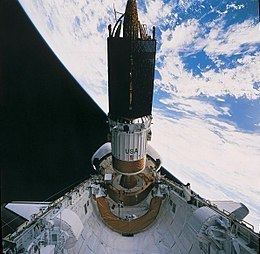COSPAR ID 1993-003B Inclination 8.74° Launch mass 3,180 kg Launch date 13 January 1993 | Launch site Kennedy LC-39B Inclination 8.74° Launch mass 3,180 kg | |
 | ||
Mission duration 10 years (planned)16+ years (achieved) Similar TDRS‑7, TDRS‑3, TDRS‑9, TDRS‑10, TDRS‑1 | ||
TDRS-6, known before launch as TDRS-F, is an American communications satellite which is operated by NASA as part of the Tracking and Data Relay Satellite System. It was constructed by TRW, and is based on a custom satellite bus which was used for all seven first generation TDRS satellites.
Contents
History
TDRS-F was deployed from Space Shuttle Endeavour during the STS-54 mission in 1993. Endeavour was launched from Launch Complex 39B at the Kennedy Space Center, at 13:59:30 GMT on 13 January 1993. TDRS-F was deployed from Endeavour around six hours after launch, and was raised to geosynchronous orbit by means of an Inertial Upper Stage.
Deployment
The two-stage solid-propellent Inertial Upper Stage made two burns. The first stage burn occurred shortly after deployment from Endeavour, and placed the satellite into a geosynchronous transfer orbit. At 02:26 GMT on 14 January it reached apogee, and the second stage fired, placing TDRS-F into geosynchronous orbit. At this point it received its operational designation, TDRS-6.
Operation
In 1994, it was placed at a longitude 46 degrees west of the Greenwich Meridian, to serve as an on-orbit spare. In 1996, it was moved to 47° West, where it remained until 2005, when it was repositioned to 174° West, where, as of August 2009, it was used to provide communications with spacecraft in Earth orbit, including Space Shuttles and the International Space Station.
